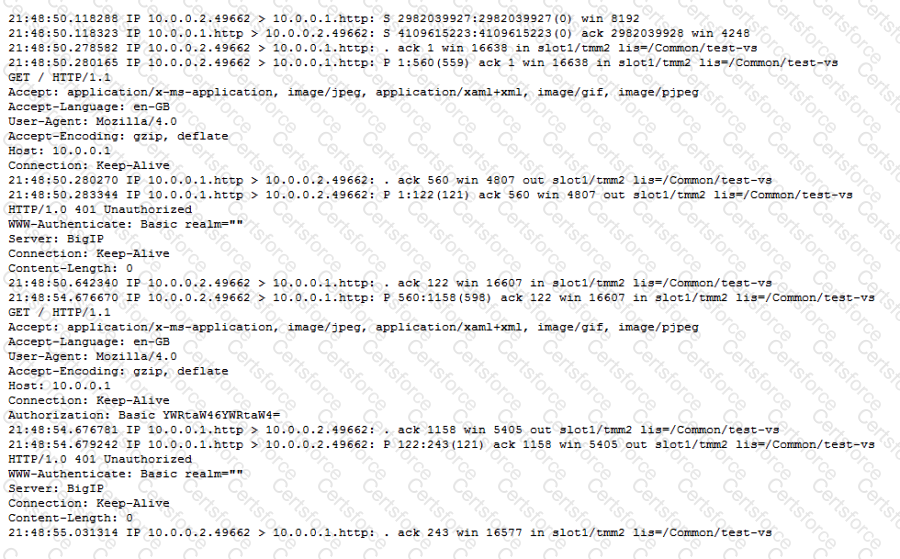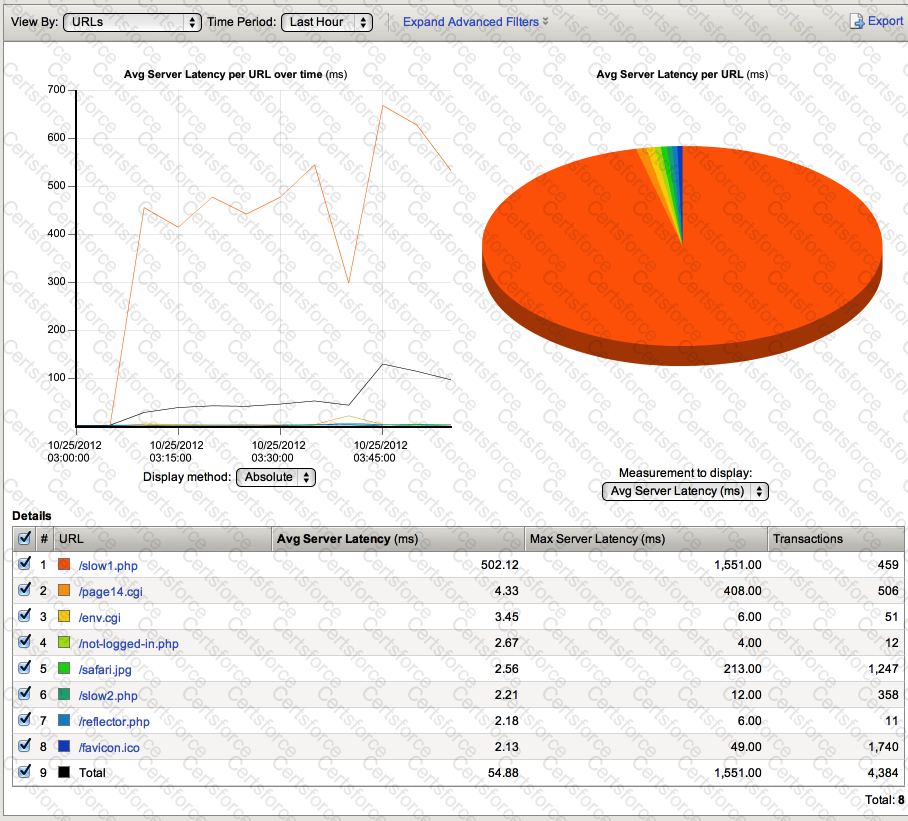-- Exhibit –

-- Exhibit --
Refer to the exhibit.
A user is unable to access an application.
What is the root cause of the problem?
-- Exhibit –

-- Exhibit --
Refer to the exhibit.
Which URL should be reported to the server/application team as getting user-visible errors?
What is the correct command to reset an LTM device to its default settings?
An application is configured on an LTM device:
Virtual server: 10.0.0.1:80 (VLAN vlan301)
SNAT IP: 10.0.0.1
Pool members: 10.0.1.1:8080, 10.0.1.2:8080, 10.0.1.3:8080 (VLAN vlan302)
Which packet capture should the LTM Specialist perform on the LTM device command line interface to capture only client traffic specifically for this virtual server?
An LTM Specialist configures the following iRule on an LTM device:
when HTTP_REQUEST {
if {[string tolower [HTTP::uri]] contains "/URI1/" } {
pool Pool1
}
elseif {[string tolower [HTTP::uri]] contains "/URI2/" } {
pool Pool2
}
elseif {[string tolower [HTTP::uri]] contains "/URI3/" } {
pool Pool3
}
else { pool Pool4}
}
Given the following request: http://www.example.comURI1/index.html?fu=bar &pass=1234
Which pool will be selected by the iRule?
The LTM Specialist is writing a custom HTTP monitor for a web application and has viewed the content by accessing the site directly via their browser. The monitor continually fails. The monitor configuration is:
ltm monitor http /Common/exampleComMonitor {
defaults-from /Common/http
destination *:*
interval 5
recv "Recent Searches"
send "GET /app/feed/current\?uid=20145 HTTP/1.1\\r\\nHost: www.example.com\\r\\nAccept-EncodinG. gzip, deflate\\r\\nConnection: close\\r\\n\\r\\n"
time-until-up 0
timeout 16
}
A trace shows the following request and response:
Request:
GET /app/feed/current?uid=20145 HTTP/1.1
Host www.example.com
Accept-Encoding gzip, deflate
Connection: close
Response:
HTTP/1.1 302 Moved Temporarily
Date Wed, 17 Oct 2012 18:45:52 GMT
Server Apache
Location https://example.com/login.jsp
Content-Encoding gzip
Content-Type text/html;charset=UTF-8
Set-CookiE. JSESSIONID=261EFFBDA8EC3036FBCC22D991AC6835; Path=/app/feed/current?uid=20145
What is the problem?
An LTM Specialist is troubleshooting an HTTP monitor. The pool member is accessible directly through a browser, but the HTTP monitor is marking the pool member as down.
GET / HTTP/1.1
HTTP/1.1 400 Bad Request
DatE. Tue, 23 Oct 2012 21:39:07 GTM
Server: Apache/2.2.22 (FreeBSD) PHP/5.4.4
mod_ssl/2.2.22 OpenSSL/0.9.8q DAV/2
Content-LengtH. 226
Connection: close
Content-TypE. text/html; charset=iso-8859-1
Which issue is the pool member having?
A failover event is recorded in the following log messages:
Jan 01 00:56:56 BIG-IP notice mcpd[5318]: 01070727:5: Pool /Common/my-pool member /Common/10.0.0.10:80 monitor status down.
Jan 01 00:56:56 BIG-IP notice sod[5855]: 010c0045:5: Leaving active, group score 10 peer group score 20.
Jan 01 00:56:56 BIG-IP notice sod[5855]: 010c0052:5: Standby for traffic group /Common/traffic-group-1.
Jan 01 00:56:56 BIG-IP notice sod[5855]: 010c0018:5: Standby
Jan 01 00:57:06 BIG-IP notice logger: /usr/bin/tmipsecd --tmmcount 4 ==> /usr/bin/bigstart stop racoon
What is the cause of the failover?
An LTM Specialist is troubleshooting a problem on an eCommerce website. The user browses the online store using port 80, adding items to the shopping cart. The user then clicks the "Checkout" button on the site, which redirects the user to port 443 for the checkout process. Suddenly, the user's shopping cart is shown as empty. The shopping cart data is stored in memory on the server, and the default source address persistence profile is used on both virtual servers.
How should the LTM Specialist resolve this issue?
An LTM Specialist is troubleshooting a problem on an eCommerce website. The user browses the online store using port 80, adding items to the shopping cart. The user then clicks the "Checkout" button on the site, which redirects the user to port 443 for the checkout process. Suddenly, the user's shopping cart is shown as empty. The shopping cart data is stored in memory on the server, and the default source address persistence profile is used on both virtual servers.
What is the issue?